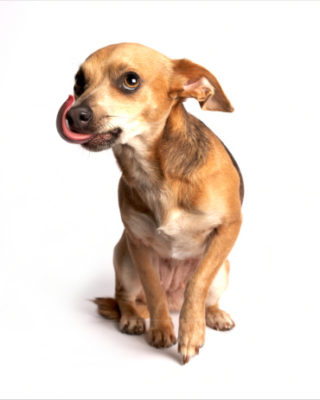
In Part 1 and 2, we explored the way dogs perceive their world and what motivates their behaviours. We looked at how they learn and how to best communicate with them. Now we will look at how the normal brain functions and what happens in the anxious dog’s brain.
In the normal brain, information about the environment is gathered through the senses and processed in part of the brain called the thalamus. From here the information travels at lightning speed to the amygdala or “danger brain” to enable rapid reactions to life threatening situations. The information travels to the cortex or “thinking brain” more slowly. We have all experienced this. For example, we jump away from a stick lying on the ground before our brain computes that it’s not really a snake.
Many behaviour issues in dogs stem from physical changes in the brain associated with anxiety. It is essential that we recognise when anxiety is causing a behaviour problem in order to seek the right help for our mate.
What happens in the anxious brain?
In the anxious dog, the danger brain hijacks the thinking brain and threats are perceived that are not real. Their amygdala is larger than normal and fires too readily and more strongly. There are also changes in the neurochemistry of the anxious brain.
So rather than being naughty, anxious dogs are physically unable to perceive situations logically and calmly with their thinking brain. Instead they react with fear behaviours and anticipate that unfamiliar situations will be frightening. They are unable to relax and cope calmly with their world.
It’s so important to understand that the brain of an anxious pet is abnormal. These are ‘special needs’ individuals with seriously compromised welfare. Not only is their experience of life negative and scary, anxiety also reduces the function of the immune system, makes pain seem worse, causes physical exhaustion and a shorter life. Importantly, it reduces the dog’s ability to think and learn better ways to cope.
How do I know that my dog is anxious?
First recognise what our dog’s body language is telling us.
There are four types of behaviours that communicate to us that a dog is frightened:
Flight response: Here your dog seeks to increase the distance from, avoid or hide from the threat.
Fight response: They may bark, growl, lunge and snap to make the threat go away.
Freeze response: They stay very still or walk as though in slow motion.
Fiddle responses: These are normal behaviours seen out of context, for example yawning when not tired, lip licking when not eating, stretching when not waking, shake off when not wet, scanning when not in danger.
It is important that we read the signs of anxiety in order to recognise and respond to fear behaviours in a way that helps our dogs cope. In time this helps them to adopt a more calm emotional state.
To understand how our dog is feeling, think about emotional states as three zones:
Green zone: This is where they are happy and relaxed. They can think, remember and learn. The behaviour is considered, ‘mature’ and predictable.
Orange zone: Here they are less able to think, remember and learn. Their behaviour is becoming more unpredictable and reactive. There is a risk of triggering quickly into the ‘red’ zone. This area is the most familiar for anxious dogs.
Red zone: ‘fight or flight’ behaviour. The behaviour is reactive and self-protective. It is more ‘immature’ and unpredictable. This emotional level can lead to aggression or desperate attempts to escape a yard to find an owner.
When your dog is in an anxious state, they are less able to respond to cues or learn new responses, as they are focused on self-preservation or what threats lurk elsewhere. Animals with anxiety live in a state of increased arousal (orange zone) and are quick to react and escalate to aggression when they feel threatened (red zone). This low threshold for reactivity, means that they are more likely to respond to innocuous triggers, for example another dog being walked past. They are less able to cope with people/children and dogs that also display reactive or confronting behaviour.
What can I do for my anxious dog?

Behaviour problems that stem from anxiety are not a training issue and should not be referred to trainers. These dogs are suffering from a medical problem and whilst training can help, they need a veterinary diagnosis and treatment. Your patience and commitment will be essential to manage their special needs and helping them learn calm ways.
Despite the fact that anxiety is a medical problem, there is a common misconception that anxious dogs just need discipline to show them who is boss to stop them behaving inappropriately. Punishment is particularly detrimental for anxious dogs and can make their behaviour worse in the long term.
Dogs – especially anxious dogs – need calm, kind and consistent handling to help them feel safe and secure in a stable environment. Consistency is the key as it minimises the stress associated with change.
We often attribute human emotions, thoughts and motivations to our pet’s behaviour and become very frustrated when they do not behave as expected or desired. Pets do not think in words and only know those few words that have been trained by association and reward. The way forward lies in no longer looking at what they should ‘stop’ doing but rather what the right behaviour would look like and how to teach him to do that. “Don’t do that, do this instead.”
Dogs have a very different view of the world than the one we assume. They are observers and live mainly in the moment. They don’t spend time plotting to do bad things or making grudges. They make decisions based on past events and learning. Their most pressing needs are finding and keeping food, staying in their safe social group, having some control over what happens to them and the ability to escape harm and fear. They quickly learn what works for them to reduce exposure to threats. Anxious aggression is not about being naughty or angry. It is fear behaviour, an attempt to avert perceived threats to keep themselves safe.
Where can I get help?
At Hall Veterinary surgery, we provide behaviour consultations for pets with behaviour problems. We recognise that these issues can have a huge impact on quality of life for both pet and owner.
Starting with a questionnaire, we discuss your observations at length and drill down for the underlying triggers and motivation for the behaviour. We then carefully craft a treatment plan that reduces opportunities to practice problem behaviours whilst teaching calm alternative responses through positive reinforcement. In some cases, medication is helpful to reduce anxiety and lower arousal levels.
Anxious pets will always spend more time in the orange and red zones than a dog without anxiety. However, over time, their emotional responses will become more normal and both pet and owner can live a more calm and relaxed life and thrive in each other’s company.
